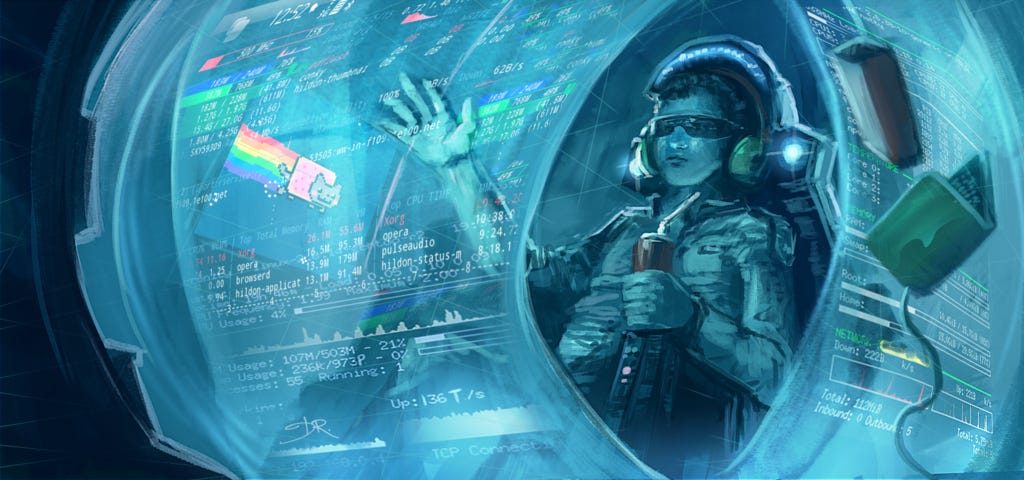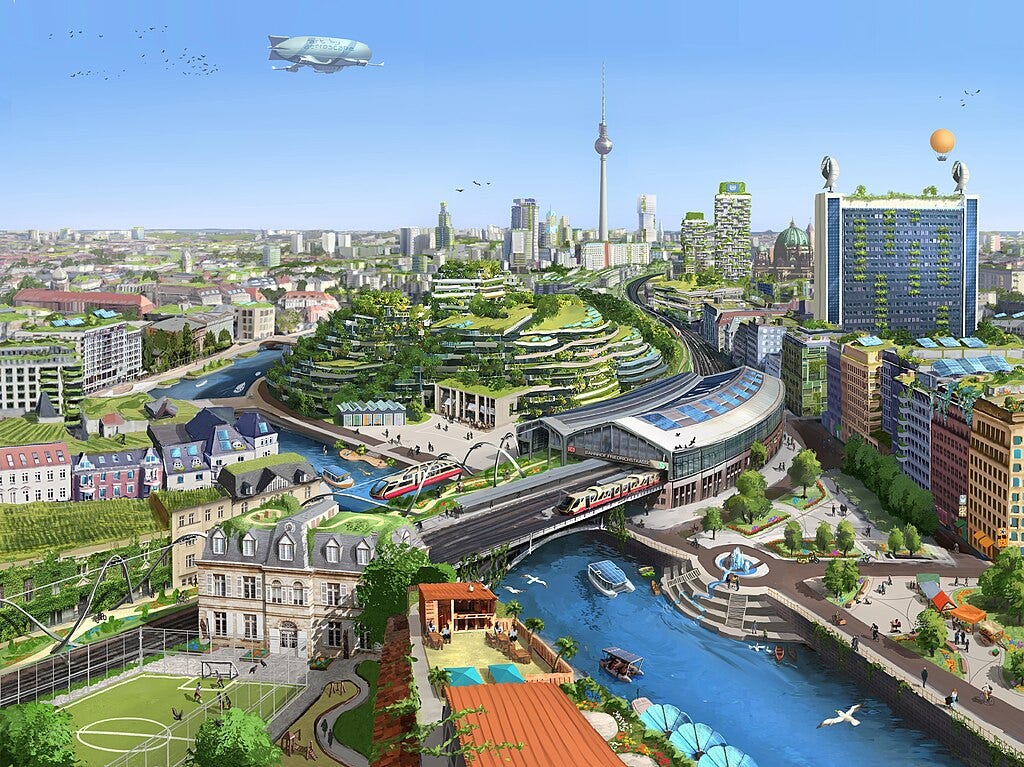People have always been good at imagining the end of the world, which is much easier to picture than the strange sidelong paths of change in a world without end.
- Rebecca Solnit, Hope in the Dark
Art guides thought. Every work consumed either reinforces the course our minds already follow or offers a fork. This is as true for audiences as it is for artists themselves. As such, the creative paths artists most often tread have been worn down by the images and influences they’ve been exposed to.
The truly original artist, then, forges a new trail only through much effort, through studying the shrouded overgrown understory that lies beside the beaten path until they spot the break of some game trail where vine and vegetation give way just enough for one to plod off in a new direction. But when the masses travel along one little wavering course, the easiest way to become a cultural vanguard is to rush ahead of the rest and report what lies ahead. This is what William Gibson accomplished with his 1984 novel Neuromancer, a book often cited as the original cyberpunk novel.

Cyberpunk, as a cultural phenomenon and sci-fi subgenre, envisions a future in which digital technologies—the computers, AI, virtual reality, and robots erupting around us—define every element of human life on Earth, and the companies that control them wield prodigious influence. In other words, cyberpunk worlds are devastatingly familiar to today’s readers, even when they’re set yet decades in the future.
Though Neuromancer is credited with kick starting the cyberpunk movement, its progenitors emerged over half a century earlier. In 1932, Aldous Huxley published Brave New World, a novel written long before the present digital and biotech revolutions ever began but which nonetheless heralded their coming. Three decades later, in 1968, Phillip K. Dick published Do Androids Dream of Electric Sheep, the novel which spawned Bladerunner starring Harrison Ford, and which features humanoid robots, a post-apocalyptic Earth, and myriad references to technologies gone awry. Still, one could argue that Neuromancer—and The Matrix a few years later—was largely responsible for popularizing cyberpunk.
Despite spending decades on the fringe and its claims to be “punk,” and therefore counterculture, cyberpunk has today been comfortably integrated into the mainstream imagination. In fact, given the familiarity of cyberpunk settings, many would have no issue arguing that the genre represents the future we’re presently marching toward. It’s why movies and books and video games in the genre pop up year after year. Yet, while these pieces of media depict their worlds with gloomy color palettes, and while the earliest exemplars of the genre portend dystopia and warn against awarding power to technocrats, many cyberpunk fans seem to cling to it with glee and unflagging optimism, eager for the day they can get their first neural implant or descend into immersive virtual reality while drones lace the sky, delivering packages.

Cyberpunk seems to derive its popularity and cultural influence from the inertial growth of today’s technology companies and the so-called innovations they’re pushing. In the last decade, millions have adopted virtual and augmented reality along with other technologies that appear poised to spark a new era of the Internet that some call Web3. We’ve also seen generative AI proliferate, cryptocurrencies and blockchain boom and bust and boom again, humanoid robots perform increasingly impressive feats, self-driving cars take to the streets in select cities, and experimental brain-computer interfaces show their first successful tests.
All of this could lead anyone to believe that we’re on the verge of cyberpunk realities, making it an easy trend to attach your artistry to. Many already have. I have a few fiction ideas of my own, pessimistic as they are, that would fit the bill as well. But while many of the thought leaders and innovators—and some of the artists—pushing these trends claim that these technologic leaps will lead to an idyllic future, we have much to worry about from that same cyberpunk style of progress.
Each of the innovations I mentioned carries social and environmental costs. Yet, the recency of these technologies means there's been yet insufficient time to study in detail the specific contours of the social fallout that this new stage of the digital revolution might bring, so I won’t much speculate here; I'll save that for my fictions. Nonetheless, if we use the impacts of social media, smartphones, and streaming as barometers of what Web3 might induce, the emerging technologies of the day are likely to further exacerbate mental illness, deepen political divisions, and widen wealth inequality—even as they promise to do the opposite.
While my fears won’t be validated (or disproven) for some time yet, the ecological impacts have already become apparent. AI, for instance, has begun to dry up water supplies for entire towns and burden nearby neighborhoods with yet more pollution all so users can cheat on school work, make memes, spread misinformation, create nonconsensual pornography, and carry out other tasks of, at best, dubious moral and ethical implications.
And few are ignorant of the tolls that will be wreaked for these dreams to manifest. Cyberpunk visions often show smog shrouded cityscapes aglow with multistory ads and neon signs pointing toward back-alley debauchery. Cyberpunk itself is in many ways an inherently depressing, defeatist vision for the future. It’s a future in which global ecology has collapsed, corporate interests have won, and our lives are lived at the whims of the wealthy. It is a future that admits defeat in the present but accepts its fate with a twisted cheer, a masochistic resignation to economic oppression because at least the rising feudal lords promise us endless hits of dopamine as we wilt in the shade of storms and skyscrapers.
But this doesn’t have to be a future we submit to without resistance. An alternative exists: solarpunk.
Where cyberpunk envisions a world captivated by digital devices and virtual advances, solarpunk focuses on the technologies that will enable a sustainable society to emerge, flourish, and thrive. Naturally, much of the emphasis is placed on solar power, electric vehicles, and the like. These are important advances no doubt, but only if they are accompanied by commensurate changes in how our cultures and economies interact with the planet, which is why I prefer the aesthetics of ecopunk. While the two are in many ways synonymous, ecopunk places the emphasis on the ways humanity must adapt to the planet if we are to live in ecological harmony with life on Earth. This means abandoning the anthropocentrism and technofuturism inherent in both contemporary culture and cyberpunk to instead cultivate a terracentric view that places ecology above all.

At it’s most basic level this means, first and foremost, setting consumerism aside along with the egocentric individualism that has infected much of the world. Ecopunk replaces the satisfaction of capricious whims and wants with a focus on meeting real needs through durable, reparable goods that mix form and function, while striving never to exceed the limits of what Earth can provide. Then, all the time spent chasing trends and putting in long hours to pursue happiness through profit to realize the dreams advertisers have fed to us can instead be put towards building relationships with family, friends, and neighbors, connecting with local wildlife, and contributing to efforts to regenerate the ecosystems ravaged by centuries of colonialism and capitalist consumerism.
While all of this would help humanity return to its role as a nurturing, prosocial ecosystem engineer as capable of caring for life as killing it, the vision is also truly punk, for it runs directly counter to the dominant cultures of our day, cultures which hunger for profit and seek to consume everything in sight. Thus, these visions are also far less common among the art and media that surround us.
After all, it is far easier to predict apocalypse and conjure pictures of dystopia when that is the direction society heads, half-conscious of the gruesome ends awaiting it. Showing how we can arrest our infernal inertia, however, and pivot onto a new path to pursue a new vision of prosperity, that is far harder. It demands an extraordinary effort on the part of those who would attempt to imagine it and convince others that it is possible. But the challenge is the core of its importance.
If humanity is ever going to halt its death march, artists must present hopeful alternatives that can form the basis for collective visioning. Otherwise, we’ll continue to walk down the road that technocapitalists have plowed and paved. Ecopunk and solarpunk, as a cultural undercurrent, offers artists the opportunity to identify new possibilities and show how they might be achieved. If enough do it, it just might jostle society off the tracks that cyberpunk pulls us down, eager for destruction.
Closing Limerick
The world that surrounds us may die
If we never learn that they lie
When they tell us Big Tech
Offers all of the feck
We might need for the rest of our lives.
